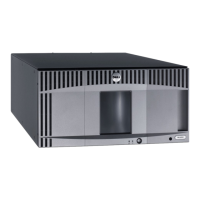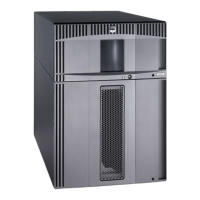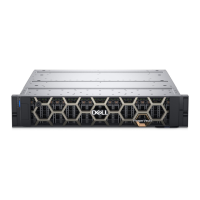Configuring Your Library
file:///T|/htdocs/stor-sys/ML6000/en/html/ch04.htm[9/17/2012 1:49:29 PM]
The path to open the appropriate screen is as follows:
• From the Web client, select Setup > Notifications > RAS > Receiver Addresses > Create.
Modifying RAS E-mail Notifications
Administrators can modify existing e-mail notification settings at any time after the e-mail notification is created. For
example, you can modify the e-mail address; add, delete, or modify a comment; change the filter level; and enable or
disable the notification. For more information on filter levels, see
Working With RAS E-mail Notifications.
The path to open the appropriate screen is as follows:
• From the Web client, select Setup > Notifications > RAS > Receiver Addresses > Modify.
Deleting RAS E-mail Notifications
Administrators can delete an e-mail notification when it is no longer needed.
The path to open the appropriate screen is as follows:
• From the Web client, select Setup > Notifications > RAS > Receiver Addresses > Delete.
Working With User Accounts
Administrators can create local user accounts on the library for local authentication, or enable and configure the Lightweight
Directory Access Protocol (LDAP) for remote authentication. You may use either or both methods, according to your needs.
This section covers how to set up user accounts and authentication for both local and remote authentication.
Local Authentication vs. Remote Authentication
Local authentication control is managed on the library. An administrator sets up accounts and privileges on the library. To use
local authentication, a user must enter a local user name and password.
Remote authentication is managed by an LDAP server. Enabling LDAP allows existing user accounts residing on an LDAP
server to be integrated into the library's current user account management subsystem. User account information is centralized
and shared by different applications, simplifying user account management tasks.
To use remote authentication, you must enable LDAP on the library. Once LDAP is enabled, users can log into the library using
either LDAP or local authentication. See
Logging in When LDAP or Kerberos is Enabled for more information.
About Local User Accounts
Administrators can create and modify two types of local user accounts: user and administrator. These users have different
library privilege levels.
• User — has access to one or more assigned partitions and can perform functions within a partition, such as
performing media and tape drive functions. A user cannot perform actions that affect the physical library, such as
creating, modifying, or deleting a partition.
• Administrator — has access to the entire physical library and all of its partitions.
The library ships with a default administrator account. The user name for this account is admin and the password is
password. You cannot delete this user account or change the user name, but you can change the password. The default
administrator account is used to perform the initial configuration of the library. If you misplace the password for the default
administrator account, contact Dell Technical Support. See
Contacting Dell.
See User Privileges for more information on library permission levels. For information on changing passwords, see Modifying
Local User Accounts.
Creating Local User Accounts
During or after the initial configuration, you can use the default administrator account to create up to eighteen additional local
user accounts, including other administrator accounts. These administrators can themselves create other local administrator

